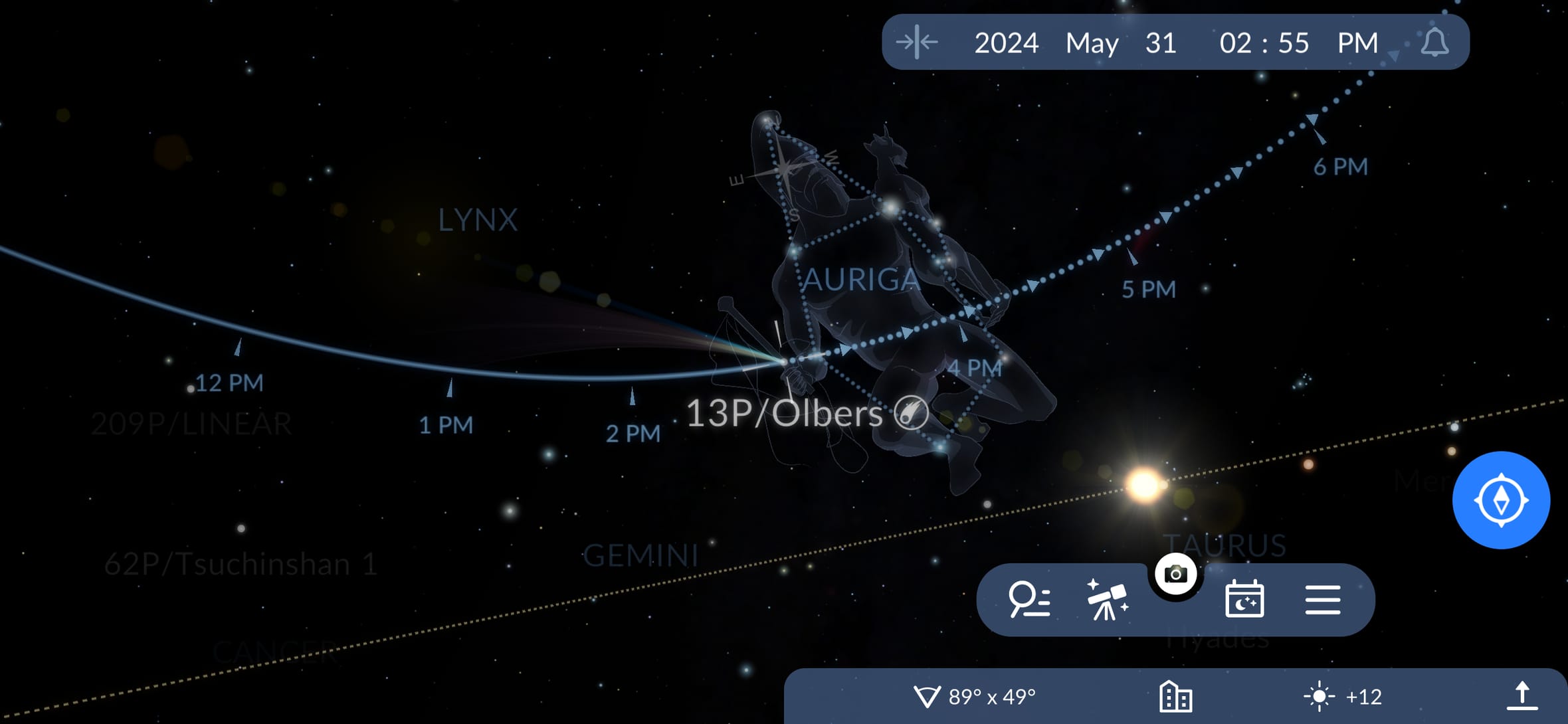Look Up: Comet 13P/Olbers Is In the Night Sky Today!
Comet 13P/Olbers is currently moving away from Earth, but is still visible in the evening sky in both hemispheres. Take your chance to see it – after this summer, the comet won't make another close approach to Earth until 2094. You can track the comet with the astronomy app Sky Tonight and observe it with your backyard telescope. Now, let's dive into more details about comet 13P/Olbers.
Contents
- Comet 13P/Olbers quick facts
- Comet 13P/Olbers tonight
- 13P/Olbers visibility forecast for 2024
- What is comet 13P/Olbers?
- When is the next comet 2024?
- Comet 13P/Olbers: bottom line
Comet 13P/Olbers quick facts
- Official name:13P/Olbers
- Type: short-period Halley-type comet
- Orbital period: 69.3 years
- Inclination: 44.67°
- Last perihelion: June 30, 2024
- Last closest approach to the Earth: July 20, 2024
- Predicted maximum brightness: 6.5
- Visible from: both hemispheres
Comet 13P/Olbers tonight
Is comet 13P/Olbers visible now?
Comet 13P/Olbers now has a magnitude of around 8 and is getting fainter by the day. It remains visible with powerful binoculars or a telescope under dark skies in both hemispheres, with the best view in the Northern Hemisphere. Also note that comets look fainter than stars with similar magnitudes, because the magnitude scale measures the total light spread out over the object, and in comets’ case this light is diffuse.
Where and when to see comet 13P/Olbers?
Comet 13P/Olbers is now in the constellation Coma Berenices and is visible on the western horizon for about 2 hours after sunset. Note that the exact position of the comet and the observation window depends strongly on your location. To find out how the comet will look tonight in your city, find 13P/Olbers in our free Sky Tonight app. Let’s see how to do it step by step.
How to find the comet in the sky?
The easiest way to locate the comet is to use the Sky Tonight app. Just open the app, type 13P/Olbers in the search bar, tap the target button next to the matching result, and you'll see the comet's location on the sky map. Then tap the blue compass button or simply point your device at the sky and – voilà – the app's sky map will adjust to your sky in real time. Follow the white arrow on the screen until you see 13P/Olbers. That's it, you've found the comet's position in the sky. Have fun observing!

13P/Olbers visibility forecast for 2024
Now let's take a look at the major points the comet will cross before it disappears.
- *August 30: mag ~9.0, passes the globular cluster M53;
- September 7: mag ~9.0, enters Bootes;
- September 10: mag ~10.0, enters Virgo;
- October 15: mag ~11.0, passes possibly naked-eye comet C/2023 A3 (Tsuchinshan-ATLAS), near the globular star cluster M5, but is poorly visible.

What is comet 13P/Olbers?
Comet 13P/Olbers is a Halley-type comet with an orbital period of 69 years. Like the other comets, it's an object composed of ice, rock, and dust. Because of this composition, comets are sometimes called "dirty snowballs" hurtling through space. That may sound unattractive, but it doesn't really make them look any worse to us on the Earth.
Want to learn more about space rocks like comets, meteors, and asteroids? Take our quiz and explore them in a fun way!

Comet 13P/Olbers name
The name of the comet contains data about where and when it was first seen:
- The letter P means the comet is periodic (a comet that takes less than 200 years to orbit the Sun);
- The number 13 means that comet Olbers was the 13th comet identified as periodic.
- Olbers indicates the name of the comet's discoverer, Heinrich Olbers.
Discovery and previous appearances
The comet was discovered in 1815 by the German astronomer Heinrich Wilhelm Matthäus Olbers, who is also famous for the formulation of the dark sky paradox. In the year of its discovery, 13P/Olbers reached a maximum magnitude of 5.
Then 13P/Olbers appeared in 1887, reaching magnitude 9 at its brightest. It went unnoticed for a while until another famous astronomer, William Brooks, accidentally found it on August 25.
In 1956, the comet returned once more. It reached a maximum magnitude of 6.5, while the tail reached a maximum length of one degree. The next time the comet will return to perihelion is on June 30, 2024, when it's expected to reach a magnitude of 6.5.

Comets have fascinated people since the beginning of time. Do you know about the biggest ones, like Halley's Comet or Hale-Bopp? Take our quiz to learn more facts about the great comets of the past!

When is the next comet 2024?
When comet Olbers is gone, keep your eyes on the sky! A potential "comet of the century," C/2023 A3 (Tsuchinshan-ATLAS), is set to approach the Earth in October 2024. Optimistic predictions suggest it could shine as bright as magnitude 0. To learn more about this exciting space traveler, check out our dedicated article.
Both comets, Tsuchinshan-ATLAS and 13P/Olbers, can be tracked in the Sky Tonight app. You can follow their paths and set up alerts for their upcoming passages. So, let's enjoy the humble beauty of comet Olbers and hope for an even more spectacular display with Tsuchinshan-ATLAS!
Comet 13P/Olbers: bottom line
13P/Olbers is a short period comet of the Halley type. Although it is now moving away from Earth, it is still visible through powerful binoculars or a telescope. Don't miss the chance to observe the comet in the sky, and use our Sky Tonight app to pinpoint its exact location above you.
